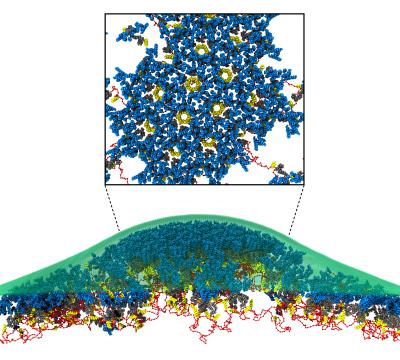Scientists find missing clue to how HIV hacks cells to propagate itself

UChicago scientists modeled how the HIV protein Gag is involved in forcing a victim's cell to make a capsule of HIV to infect other cells, a process called "budding." Credit: Voth et. al / University of Chicago
A key part of HIV's success is a nasty little trick to propagate itself inside the body. Once HIV has infected a cell, it forces the cell to make a little capsule out of its own membrane, filled with the virus. The capsule pinches off–a process called “budding”–and floats away to infect more cells. Once inside another unsuspecting cell, the capsule coating falls apart, and the HIV RNA gets to work.
Scientists knew that budding involves an HIV protein complex called Gag protein, but the details of the molecular process were murky. “For a while now we have had an idea of what the final assembled structure looks like, but all the details in between remained largely unknown,” said Gregory Voth, the Haig P. Papazian Distinguished Service Professor of Chemistry and corresponding author on the paper.
Since it's been difficult to get a good molecular-level snapshot of the protein complex with imaging techniques, Voth and his team built a computer model to simulate Gag in action.
Simulations allowed them to tweak the model until they arrived at the most likely configurations for the molecular process, which was then validated by experiments in the laboratory of Jennifer Lippincott-Schwartz at the National Institutes of Health and the Howard Hughes Medical Institute Janelia Research Campus.
They built a model of missing parts of the Gag protein complex, and tweaked it until they could see how the proteins assemble by taking advantage of cellular infrastructure in preparation for the budding process.
“It really demonstrates the power of modern computing for simulating viruses,” Voth said.
“The hope is that once you have an Achilles' heel, you can make a drug to stop Gag accumulation and hopefully arrest the virus's progression.”
The team plans next to study the structures of the Gag proteins in the HIV virus capsule after budding, he said.
###
Other UChicago authors on the paper were postdoctoral researcher Alexander Pak, researcher John Grime and graduate student Aleksander Durumeric.
Media Contact
All latest news from the category: Life Sciences and Chemistry
Articles and reports from the Life Sciences and chemistry area deal with applied and basic research into modern biology, chemistry and human medicine.
Valuable information can be found on a range of life sciences fields including bacteriology, biochemistry, bionics, bioinformatics, biophysics, biotechnology, genetics, geobotany, human biology, marine biology, microbiology, molecular biology, cellular biology, zoology, bioinorganic chemistry, microchemistry and environmental chemistry.
Newest articles

A ‘language’ for ML models to predict nanopore properties
A large number of 2D materials like graphene can have nanopores – small holes formed by missing atoms through which foreign substances can pass. The properties of these nanopores dictate many…

Clinically validated, wearable ultrasound patch
… for continuous blood pressure monitoring. A team of researchers at the University of California San Diego has developed a new and improved wearable ultrasound patch for continuous and noninvasive…

A new puzzle piece for string theory research
Dr. Ksenia Fedosova from the Cluster of Excellence Mathematics Münster, along with an international research team, has proven a conjecture in string theory that physicists had proposed regarding certain equations….



